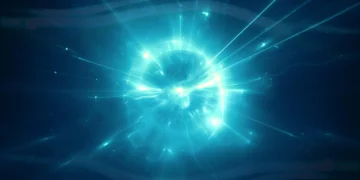For decades, physicists have searched for the elusive dark matter, the invisible substance that makes up about 85% of the universe’s mass but remains undetectable by conventional methods. A recent breakthrough, however, may bring us closer to understanding this cosmic mystery. Scientists studying ytterbium isotopes have observed unexpected anomalies, which could either point to a hidden dark force or reveal new properties of atomic nuclei.
A Strange Isotope Shift Sparks Curiosity
Physicists at MIT first noticed something odd in 2020 while studying ytterbium isotopes—different forms of the same element with varying numbers of neutrons. Their experiments revealed an unexpected nonlinear shift in isotope behavior, which did not align with existing nuclear theories .
This surprising result triggered further investigations, with research teams from the Physikalisch-Technische Bundesanstalt (PTB), Max Planck Institute for Nuclear Physics (MPIK), and Technical University of Darmstadt conducting high-precision experiments to confirm and explain the anomaly.
How Scientists Measured the Anomaly
To understand this phenomenon, researchers used two advanced techniques:
- Ion Traps & Ultra-Stable Lasers (PTB’s Laboratory): Scientists measured atomic transition frequencies with extreme accuracy, studying how electrons interact with the nucleus.
- Penning Trap Mass Spectrometry (MPIK’s Laboratory): A state-of-the-art spectrometer provided the most precise measurements of isotope mass ratios to date—100 times more accurate than previous studies (MPIK, 2025).
These cutting-edge technologies allowed researchers to confirm the isotope shift anomaly, proving it was not an experimental error.
Dark Matter and the Search for Hidden Forces
Dark matter interacts with normal matter only through gravity, but some scientists theorize the existence of a “dark force”—a previously unknown interaction between neutrons and electrons that could bridge dark matter with the visible universe.
If such a force exists, it would leave subtle imprints on atomic behavior, like the ytterbium isotope shift detected in these experiments.
What Scientists Have Found So Far
While the ytterbium anomaly could hint at a dark force, further analysis suggests an alternative explanation—nuclear deformation. Researchers found that the anomaly may stem from the way atomic nuclei stretch and deform as neutrons are added.
However, this study has set new constraints on how strong a dark force could be. It effectively narrows down the possibilities and provides a roadmap for future research.
How This Discovery Impacts Nuclear Physics
By analyzing ytterbium’s isotope chain, scientists obtained direct data on nuclear deformation, providing valuable insight into the structure of heavy atomic nuclei. This information is crucial for:
- Understanding neutron-rich matter, which plays a role in extreme cosmic environments.
- Modeling neutron stars, whose dense interiors behave similarly to atomic nuclei.
- Developing next-generation nuclear models that better explain atomic structure.
This finding reinforces how atomic, nuclear, and particle physics are deeply connected, demonstrating that advances in one field can lead to breakthroughs in another.
Why This Discovery is So Important
1. It Bridges the Gap Between Atomic, Nuclear, and Particle Physics
This study highlights the interdisciplinary nature of modern physics. By combining high-precision atomic measurements with nuclear theory, scientists have developed a new method to study fundamental forces.
2. It Helps Define the Limits of Dark Matter Interactions
Although the ytterbium anomaly does not confirm a dark force, it establishes stricter limits on where and how scientists should look for them, refining our search strategies for dark matter.
3. It Pushes the Boundaries of High-Precision Physics
The techniques used in this study set a new standard for accuracy in isotope measurements, paving the way for future discoveries in quantum mechanics, astrophysics, and fundamental physics.
What Comes Next?
Future Research Directions
Scientists are already planning follow-up experiments to further test these findings:
- Expanding research to other isotopic elements to see if similar anomalies exist.
- Using next-generation quantum sensors to achieve even higher precision in atomic measurements.
- Conducting new particle physics experiments to search for dark forces in other ways.
With upcoming advancements in quantum optics, particle accelerators, and space-based telescopes, our ability to probe the fundamental forces of the universe will only improve.
Conclusion: A New Chapter in Fundamental Physics
This discovery of anomalous isotope shifts in ytterbium is a major step forward in our understanding of atomic and nuclear physics. While the dream of uncovering a dark force remains unfulfilled, the study has provided crucial new insights into nuclear structure, neutron stars, and dark matter constraints.
Reference:
Probing New Bosons and Nuclear Structure with Ytterbium Isotope Shifts



















